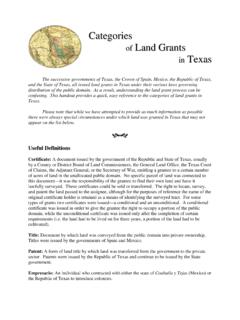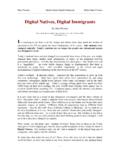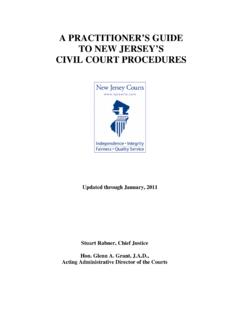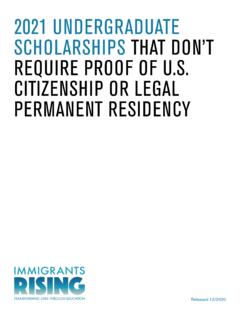Transcription of Assimilation and Pluralism - SAGE Publications Inc
1 43 2 Assimilation and PluralismFrom Immigrants to White EthnicsWe have room for but one flag, the American flag.. We have room for but one language here, and that is the English language .. and we have room for but one loyalty and that is a loyalty to the American people. Theodore Roosevelt, 26th President of the United States, 1907 This chapter continues to look at the ways in which ethnic and racial groups in the United States relate to one another. Two concepts, Assimilation and Pluralism , are at the core of the discussion. Each includes a variety of possible group relations and pathways along which group relations might is a process in which formerly distinct and separate groups come to share a common culture and merge together socially.
2 As a society undergoes Assimilation , differences among groups decrease. Pluralism , on the other hand, exists when groups maintain their individual identities. In a pluralistic society, groups remain separate, and their cultural and social differences persist over some ways, Assimilation and Pluralism are contrary processes, but they are not mutu-ally exclusive. They may occur together in a variety of combinations within a particular society or group. Some groups in a society may be assimilating as others are maintaining (or even increasing) their differences. As we shall see in Part III, virtually every minority group in the United States has, at any given time, some members who are assimilating and others who are preserving or reviving traditional cultures.
3 Some Native Americans, for example, are pluralistic. They live on or near reservations, are strongly connected to their heritage, and speak their native languages. Other Native Americans are very much assimilated into the dominant society: They live in urban areas, speak English only, and know relatively little about their traditional cultures. Both Assimilation and Pluralism are important forces in the everyday lives of Native Americans and most other minority PART I AN INTRODUCTION TO THE STUDY OF MINORITY GROUPS IN THE UNITED STATESA merican sociologists have been very concerned with these processes, especially assim-ilation. This concern was stimulated by the massive immigration from Europe to the United States that occurred between the 1820s and the 1920s.
4 More than 31 million people crossed the Atlantic during this time, and a great deal of energy has been devoted to documenting, describing, and understanding the experiences of these immigrants and their descendants. These efforts have resulted in the development of a rich and complex literature that I will refer to as the traditional perspective on how newcomers are incor-porated in chapter begins with a consideration of the traditional perspective on both assimila-tion and Pluralism and a brief examination of several other possible group relationships. The concepts and theories of the traditional perspective are then applied to European immigrants and their descendants, and we develop a model of American Assimilation based on these experiences.
5 This model will be used in our analysis of other minority groups throughout the text and especially in Part United States is now experiencing its second mass immigration, which began in the mid-1960s, and a particularly important issue is whether the theories, concepts, and models based on the first mass immigration (from the 1820s to the 1920s) will apply to the second. The newest arrivals differ in many ways from those who came earlier, and ideas and theories based on the earlier experiences will not necessarily apply to the present. We will briefly note some of the issues in this chapter and explore them in more detail in the case study chapters in Part , at the end of this chapter, I briefly consider the implications of these first two chapters for the exploration of intergroup relations.
6 By the end of this chapter, you will be familiar with many of the concepts that will guide us throughout this text as we examine the variety of possible dominant-minority group situations and the directions our society (and the groups within it) can begin with Assimilation because the emphasis in group relations historically has been on this goal rather than on Pluralism . This section presents some of the most important sociological theories and concepts that have been used to describe and analyze the Assimilation of the 19th-century immigrants from of AssimilationAssimilation is a general term for a process that can follow a number of different pathways. One form of Assimilation is expressed in the metaphor of the melting pot, a process in which different groups come together and contribute in roughly equal amounts to create a common culture and a new, unique society.
7 People often think of the American experience of Assimilation in terms of the melting pot. This view stresses the ways in which diverse peoples helped construct society and made contributions to American culture. The melting-pot metaphor sees Assimilation as benign and egalitarian, a process that emphasizes sharing and it is a powerful image in our society, the melting pot is not an accurate description of how Assimilation actually proceeded for American minority groups (Abrahamson, 1980, pp. 152 154). Some groups especially the racial minority groups have been largely excluded from the melting process. Furthermore, the melting- pot brew has had a distinctly Anglocentric flavor: For better or worse, the white Chapter 2 Assimilation and Pluralism 45 Anglo-Saxon Protestant tradition was for two centuries and in crucial respects still is the dominant influence on American culture and society (Schlesinger, 1992, p.)
8 28). Contrary to the melting-pot image, Assimilation in the United States generally has been a coercive and largely one-sided process better described by the terms Americanization or Anglo-conformity. Rather than an equal sharing of elements and a gradual blending of diverse peoples, Assimilation in the United States was designed to maintain the predomi-nance of the English language and the British-type institutional patterns created during the early years of American society. The stress on Anglo-conformity as the central thrust of American Assimilation is clearly reflected in the quote from President Roosevelt that opens this chapter. Many Americans today agree with Roosevelt: 77% of respondents in a recent survey the overwhelming majority agreed that the United States should require immi-grants to be proficient in English as a condition of remaining in the Interestingly, about 60% of Hispanic Americans (vs.
9 80% of non-Hispanic whites and 76% of blacks) also agreed with this statement (Carroll, 2007). We should note that the apparent agree-ment between whites and Hispanics on the need for immigrants to learn English may flow from very different orientations and motivations. For some whites, the response may mix prejudice and contempt with support for Americanization, while the Hispanic responses may be based on direct experience with the difficulties of negotiating the monolingual institutions of American Anglo-conformity, immigrant and minority groups are expected to adapt to Anglo-American culture as a precondition to acceptance and access to better jobs, education, and other opportunities. Assimilation has meant that minority groups have had to give up their traditions and adopt Anglo-American culture.
10 To be sure, many groups and individuals were (and continue to be) eager to undergo Anglo-conformity, even if it meant losing much or all of their heritage. For other groups, Americanization created conflict, anxiety, demoraliza-tion, and resentment. We assess these varied reactions in our examination of America s minority groups in Part happens on many levels, including food. In this photo, a New York deli offers food from several ethnic traditions (Jewish, Italian, and Middle Eastern) brought together in a distinctly American venue. PART I AN INTRODUCTION TO THE STUDY OF MINORITY GROUPS IN THE UNITED STATESThe Traditional Perspective on Assimilation : Theories and ConceptsAmerican sociologists have developed a rich body of theories and concepts based on the Assimilation experiences of the immigrants who came from Europe from the 1820s to the 1920s, and we shall refer to this body of work as the traditional perspective on Assimilation .


















